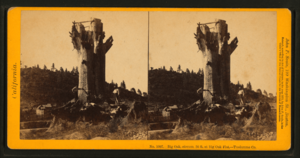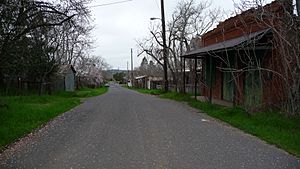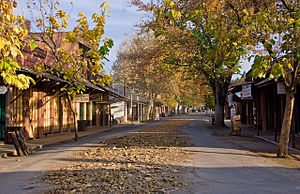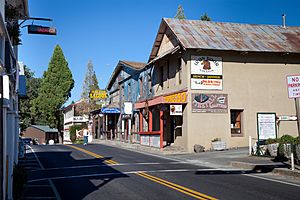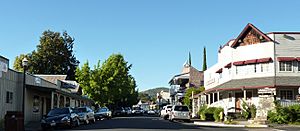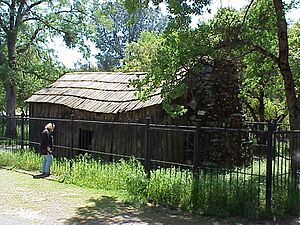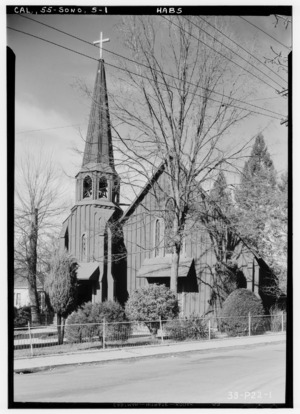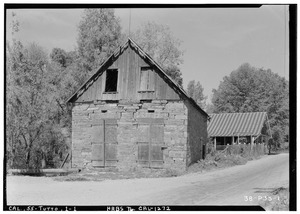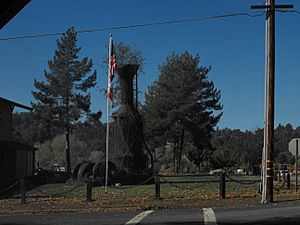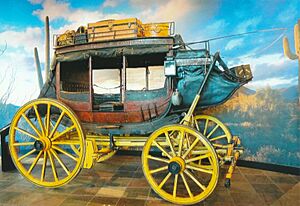California Historical Landmarks in Tuolumne County facts for kids
Tuolumne County, California, is a place rich in history, especially from the exciting days of the California Gold Rush! Many important spots in this county are recognized as California Historical Landmarks. These landmarks help us remember and learn about the past. They show us where significant events happened, where famous people lived, or where important buildings stood.
This article will take you on a journey through some of these amazing historical places in Tuolumne County. You'll discover old towns, famous cabins, and other sites that played a big part in shaping California's story.
Contents
- Exploring Tuolumne County's Historic Landmarks
- Big Oak Flat
- Cherokee
- Chinese Camp
- Columbia
- Groveland
- Jacksonville
- Jamestown
- Mark Twain Cabin
- Montezuma
- Parrott's Ferry
- St. James Episcopal Church
- Sawmill Flat
- Second Garrote
- Shaw's Flat
- Sonora-Mono Road
- Soulsbyville
- Springfield
- Tuttletown
- Summersville (Tuolumne City)
- Wells Fargo Express Company Building
- Images for kids
Exploring Tuolumne County's Historic Landmarks
Tuolumne County has many places that are officially recognized as California Historical Landmarks. These special spots are protected so that future generations can learn about their history. Let's explore some of them!
Big Oak Flat
Big Oak Flat is a historic area near Big Oak Flat. It gets its name from a giant oak tree that once stood here. This town was an important stop for miners and travelers heading to the gold fields during the Gold Rush. It was a busy place with stores, saloons, and homes.
Cherokee
Cherokee is another historic spot located near Tuolumne City. While there isn't a specific image for this landmark, it marks a significant location from the Gold Rush era. Many small mining camps and settlements popped up all over Tuolumne County during this time, and Cherokee was one of them.
Chinese Camp
Chinese Camp is a very important historic district. It was one of the largest settlements for Chinese miners during the Gold Rush. These miners played a huge role in developing California's mining industry. The town still has buildings that remind us of its unique past.
Columbia
Columbia is one of the most famous Gold Rush towns. It's so well-preserved that it's now a Columbia State Historic Park. When you visit Columbia, it feels like stepping back in time! You can see old buildings, ride a stagecoach, and even try panning for gold. It's a great place to learn about daily life during the Gold Rush.
Groveland
Groveland is another historic district in Tuolumne County. It was originally a mining camp called "First Garrote" during the Gold Rush. Later, it became an important supply center for miners and travelers heading to Yosemite National Park. Its historic buildings tell stories of its past as a lively mountain town.
Jacksonville
Jacksonville was once a bustling mining town located near the Don Pedro Bridge. Today, it's mostly submerged under the Don Pedro Reservoir, but a vista point marks its historic location. It was an important crossing point on the Tuolumne River for miners and supplies.
Jamestown
Jamestown is a historic district known for its connection to the Gold Rush and the railroad. It was a lively mining town and later became a key stop on the Sierra Railway. You might even recognize some parts of Jamestown from movies and TV shows, as it's a popular filming location!
Mark Twain Cabin
The Mark Twain Cabin is located near Tuttletown. This simple cabin is famous because the well-known American writer, Mark Twain, lived here for a short time in 1864. It was during his stay here that he gathered ideas and inspiration for some of his most famous stories, including "The Celebrated Jumping Frog of Calaveras County."
Montezuma
Montezuma is a historic site along State Highway 49, near Chinese Camp. Like many places in the county, it was a small settlement that grew during the Gold Rush. These smaller camps were vital parts of the larger mining network.
Parrott's Ferry
Parrott's Ferry marks the location of an old ferry crossing on the Stanislaus River, near Columbia. Before bridges were common, ferries were essential for people and goods to cross rivers. This spot was a crucial link for travelers and miners moving between Tuolumne and Calaveras counties.
St. James Episcopal Church
The St. James Episcopal Church is a beautiful historic building in Sonora. Built in the 1800s, it's a wonderful example of the architecture from the Gold Rush era. Churches like this were important centers for the community, providing spiritual guidance and social gatherings.
Sawmill Flat
Sawmill Flat is a historic district near Columbia. As its name suggests, it was likely a place where timber was cut and processed. Sawmills were crucial for building homes, businesses, and mining structures in the rapidly growing Gold Rush towns.
Second Garrote
Second Garrote is another historic site along State Highway 120, near Groveland. Like its neighbor, First Garrote (Groveland), it was a mining camp that played a role in the early days of the Gold Rush.
Shaw's Flat
Shaw's Flat is a historic area near Columbia. It was one of the many flat areas in the region where miners set up camps and searched for gold. These "flats" were often good spots for placer mining, where gold was found in riverbeds and shallow deposits.
Sonora-Mono Road
The Sonora-Mono Road is a historic route near Sugar Pine. This road was a vital pathway connecting the mining towns of Tuolumne County with the silver mines on the eastern side of the Sierra Nevada mountains. It was a challenging journey but essential for trade and transportation.
Soulsbyville
Soulsbyville is a historic district that was once a significant mining town. It was known for its hard rock mining, where miners dug deep into the earth to extract gold. The town was named after a prominent miner, and its history is tied to the deeper, more industrial side of the Gold Rush.
Springfield
Springfield is a historic district near Springfield. This area was another active mining camp during the Gold Rush. Many small settlements like Springfield popped up wherever gold was discovered, creating a network of communities across the county.
Tuttletown
Tuttletown is a historic district that was a popular stop for miners and travelers. It's famous for its connection to Mark Twain, who spent time here. The town still has historic buildings, like Swerer's Store, that show what life was like in a Gold Rush supply center.
Summersville (Tuolumne City)
Summersville, also known as Tuolumne City, is a historic district. This town was an important center for the timber industry, which grew after the initial Gold Rush. It also served as a hub for mining activities in the surrounding areas.
Wells Fargo Express Company Building
The Wells Fargo Express Company Building is located in Chinese Camp. Wells Fargo was a very important company during the Gold Rush, providing banking, express mail, and stagecoach services. This building was a key part of their operations in the area, helping miners send their gold and receive supplies.
Images for kids


